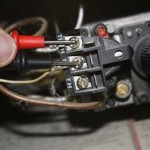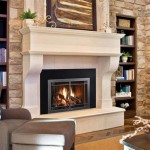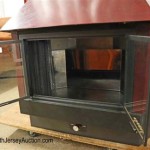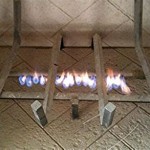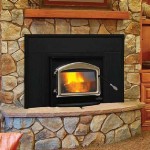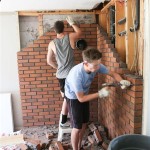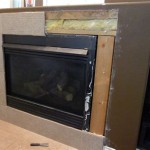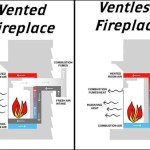Large Fireplace Screen: Enhancing Safety and Aesthetics
A fireplace is a focal point in many homes, providing warmth and ambiance. However, an open fireplace presents certain safety risks, primarily related to sparks, embers, and direct contact with the fire. A large fireplace screen serves as a crucial barrier, mitigating these risks while also enhancing the aesthetic appeal of the hearth. The selection of an appropriate large fireplace screen involves considering several factors, including material, dimensions, design, and safety features.
The primary function of a large fireplace screen is to prevent sparks and embers from escaping the firebox and landing on the surrounding floor or furniture. This is particularly important in homes with flammable materials such as rugs, carpets, or wood flooring. Embers can smolder undetected for extended periods before igniting, potentially leading to a house fire. A properly constructed screen acts as a physical barrier, containing these hazards within the fireplace.
Beyond safety, a large fireplace screen can significantly contribute to the overall aesthetic of the room. Screens are available in a wide variety of styles, from traditional wrought iron designs to modern, minimalist constructions. They can complement the existing décor, add a touch of elegance, or even become a statement piece in their own right. The choice of screen style should align with the homeowner's personal preferences and the overall design scheme of the living space.
Key Point 1: Material Selection and Durability
The material used in the construction of a large fireplace screen is a critical factor determining its durability, heat resistance, and overall lifespan. Common materials include steel, wrought iron, stainless steel, and tempered glass. Each material offers a unique combination of properties that affect its suitability for use in a fireplace environment.
Steel is a widely used material due to its strength and affordability. Steel screens are generally powder-coated or painted to prevent rust and corrosion. The powder coating also provides a more aesthetically pleasing finish. However, steel can be susceptible to deformation under prolonged exposure to high temperatures, particularly thinner-gauge steel. The thickness of the steel used in the screen's construction is a key indicator of its resistance to heat-induced warping.
Wrought iron is a more durable and heat-resistant option compared to steel. Wrought iron screens are often handcrafted, featuring intricate designs and patterns. The higher density of wrought iron makes it less prone to warping and deformation, even under intense heat. Wrought iron screens also tend to be heavier and more stable, providing a more substantial barrier against escaping embers.
Stainless steel offers excellent corrosion resistance and a modern aesthetic. Stainless steel screens are typically more expensive than steel or wrought iron options, but their durability and low maintenance requirements can make them a worthwhile investment. Stainless steel is also resistant to rust and oxidation, ensuring a long lifespan even with frequent use.
Tempered glass screens provide a clear view of the fire while blocking sparks and embers. Tempered glass is heat-resistant and shatter-resistant, making it a safe and effective barrier. However, tempered glass screens can be more expensive and require careful handling to avoid damage. They are also more susceptible to scratches and smudges compared to metal screens.
The choice of material should be based on a balance of factors, including budget, aesthetic preferences, and the anticipated frequency of fireplace use. For high-use fireplaces, a more durable and heat-resistant material such as wrought iron or stainless steel is recommended. For occasional use, a steel screen may be a suitable and cost-effective option.
Key Point 2: Dimensions and Fit
Proper sizing and fit are essential for a large fireplace screen to function effectively and safely. The screen should completely cover the fireplace opening, preventing sparks and embers from escaping around the edges. The dimensions of the fireplace opening should be carefully measured before selecting a screen. These measurements should include the width, height, and depth of the opening.
The width of the screen should be at least several inches wider than the fireplace opening to ensure adequate coverage. This overlap helps prevent embers from bouncing around the edges of the screen. The height of the screen should also be sufficient to cover the entire opening, including the top of the firebox. A screen that is too short may allow sparks to escape over the top.
The depth of the screen is also an important consideration, particularly for fireplaces with a deep firebox. The screen should be deep enough to provide sufficient clearance between the fire and the screen. This helps prevent the screen from overheating and reduces the risk of damage. A general rule of thumb is to allow at least 6-12 inches of clearance between the fire and the screen.
Screens are available in various shapes, including flat, arched, and three-panel designs. Flat screens are the most common and are suitable for rectangular fireplace openings. Arched screens are designed to fit arched fireplace openings, providing a more custom and aesthetically pleasing look. Three-panel screens offer added stability and flexibility, allowing them to be adjusted to fit various fireplace shapes and sizes. The side panels of a three-panel screen can be angled inward to provide a more secure fit and prevent drafts.
In addition to the overall dimensions, the mesh size of the screen is also important. The mesh should be fine enough to prevent sparks and embers from passing through, but open enough to allow sufficient airflow to the fire. A mesh size of 1/4 inch or smaller is generally recommended for optimal spark protection.
Key Point 3: Design and Style Considerations
While safety and functionality are paramount, the design and style of a large fireplace screen play a significant role in its overall appeal. The screen should complement the existing décor and enhance the aesthetic of the room. Screens are available in a wide range of styles, from traditional to contemporary, allowing homeowners to choose a screen that reflects their personal taste.
Traditional fireplace screens often feature intricate wrought iron designs, such as scrollwork, floral patterns, or geometric shapes. These screens can add a touch of elegance and sophistication to a traditional living room. Finishes such as antique bronze, black, or pewter are commonly used to complement traditional décor.
Contemporary fireplace screens typically have a more minimalist design, with clean lines and simple geometric shapes. Stainless steel or black powder-coated finishes are often used to create a modern and sleek look. Some contemporary screens may also incorporate glass panels or other decorative elements.
The color and finish of the screen should also be considered in relation to the surrounding décor. A black screen can provide a striking contrast against a light-colored fireplace surround, while a brass or bronze screen can add warmth and richness to a room. The finish should also be durable and resistant to heat and wear.
Some screens feature decorative accents, such as handles, finials, or embellishments. These details can add visual interest and enhance the overall aesthetic of the screen. However, it is important to ensure that any decorative elements are securely attached and do not pose a safety hazard.
Ultimately, the choice of design and style is a matter of personal preference. Homeowners should consider their existing décor, personal taste, and the overall aesthetic of the room when selecting a large fireplace screen. A well-chosen screen can enhance the beauty of the fireplace and create a more inviting and comfortable living space.
The selection of a large fireplace screen is an important decision that involves considering various factors. By carefully evaluating the material, dimensions, design, and safety features of different screens, homeowners can choose a screen that provides both safety and aesthetic appeal. A properly chosen screen will protect the home from sparks and embers while also enhancing the beauty of the fireplace and the overall ambiance of the room.

Large Two Door Fireplace Screen With Glass Fl Panels Black Plow Hearth

Pilgrim Large Tri Panel Arched Fireplace Screen

Large Crest Fireplace Screen With Doors Black Plow Hearth

Plow Hearth Large Crest Flat Guard Fireplace Fire Screen Target

Large Mountain Cabin Fire Screen With Door Black Plow Hearth

View All Fireplace Screens Pilgrim Home Hearth

Plow Hearth Large Cast Iron Scrollwork Fireplace Fire Screen With Doors 44 W X 33 H Target

Large Olde World Fireplace Screen Woodland Direct

Kingdely Large Black Powder Coated 1 Panel Steel Frame Metal Mesh Free Standing Spark Guard Fireplace Screen With Hinged Doors Tdjw Ebkf170009 The Home Depot

Plow Hearth Large Tree Of Life Fireplace Metal Fire Screen With Door Target
Related Posts

